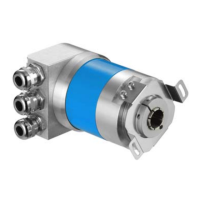Introduction
6 ATM60-Cxx 03/2007
4. Introduction
4.1 CAN general
The ATM60-Cxx is an absolute encoder for use in a CAN network. The CANopen protocol, based on CAN, is
used for data transmission.
CAN was originally developed by Bosch for use in motor vehicles. The area of use of this bus system has
expanded considerably since then. Nowadays, CAN is used in mobile systems, as a communication system
within machinery or plant, in the field area of production automation, in building services engineering and in
many other sectors.
CAN has a line structure, a twisted two-wire line being used as the transmission medium. The electrical levels
are designed in accordance with ISO DIS 11898.
A main feature of CAN is the object-oriented data transmission. For this purpose, no bus participants (nodes)
are addressed, instead each variable to be transmitted is marked by a network-wide defined identifier. In
addition, in order to identify the messages, the priority of the respective variable is simultaneously defined by
the identifier during the system configuration. The allocation of priorities for the bus access method used is
necessary.
4.2 CAN Application Layer (CAL)
In order to facilitate the use of CAN in industrial applications, the “CAN in automation” (CiA) user organization
has defined a universal application interface with communications and management services for CAN
networks, the “CAN Application Layer” (CAL).
4.3 CANopen
CANopen was defined as a subset of CAL (CAN Application Layer) and, in addition, contains some
extensions specifically for industrial real-time systems. A distinction is drawn between the communications
profile and the device profile. In the communications profile (CiA DS 301), the type and manner of data
interchange between the participants is defined. In the device profile, the functionality of the participant is
defined.
4.3.1 CANopen communications profile
The communications profile of CANopen CiA DS 301 describes which properties of CAL are used in which
form. Typically, two types of communication occur in a network. Firstly, there are relatively large blocks, which
often contain configuration data, as they are known. Therefore, they are normally transmitted comparatively
rarely, and are relatively uncritical in terms of time behaviour. Secondly, there is the process data. These are
typically rather small information blocks with a high repetition rate and high requirements on uniform time
behaviour.
In work
In Arbeit

